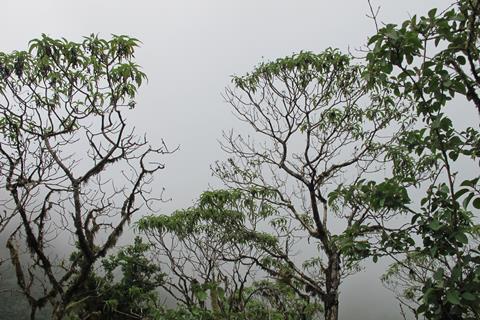An international research team led by the Netherlands Institute of Ecology (NIOO-KNAW) is to search for invisible life in the Galápagos Islands.
The Galápagos Microbiome Project - a group of scientists from the Netherlands, Ecuador, Spain and Brazil - intends to probe the uniqueness and diversity of microbial life on the islands, which are famous for their association with Darwin. It could improve our understanding of the co-evolution of species.

The researchers plan to sample both bacteria and fungi (the ‘microbiome’) and their host plants.
“It’s really motivating for us to follow in Darwin’s footsteps and profile the diversity of microbes on and inside of wild plant species,” says project leader Jos Raaijmakers, head of Microbial Ecology at the Netherlands Institute of Ecology (NIOO-KNAW) and professor at Leiden University.
Giant daisies
Insights from the expedition could make an important contribution to the preservation of endangered plant species, including Scalesia: the giant daisy. It’s found on the uninhabited islands in the archipelago in particular.
Scalesia grows on fertile soil, which is in great demand for agriculture outside of nature reserves. Other threats to these unique endemic plants are grazing goats, invasive plant species and extreme climate conditions.
Scalesia has been dubbed the Darwin’s finch of the plant world. Just like the famous group of bird species Darwin found in Galápagos and used as inspiration for his theory of evolution, the members of the Scalesia family differ substantially between sites and between islands. Scalesia may be a modest shrub growing among pumice stones in one place, but a veritable tree surrounded by cloud forest in another. Adapting to local circumstances, Scalesia has developed a huge variety that has resulted in at least 15 different species.
Micro-friends
The question is whether micro-organisms have also adapted and developed great diversity across the islands, and what is their role in the ecology of the endemic host plant. Finding out more about the plants’ as yet unknown microbial partners will hopefully turn out to be the key to supporting their growth and survival.
“It’s an invisible world that would have been impossible to study in such detail in Darwin’s day,” Raaijmakers explains. “Current DNA-techniques allow us to unravel the diversity of microbes, and study if it is in line with their host plants’ speciation on different islands in the archipelago.”
The international team comprising six researchers and a film maker will start their 12-day expedition to a number of uninhabited Galápagos Islands on 25 March, using their ship as a base. Project leader Raaijmakers has been working closely with Pieter van ’t Hof and Gonzalo Rivas-Torres from the Universidad San Francisco de Quito in Ecuador to make the search for the different species of giant daisy possible.
These researchers and their team have ample experience when it comes to expeditions to Galápagos, and they play a key role in the ‘Galapagos Barcode Project’: an ambitious undertaking that aims to document the genetics of all species on the islands and in the surrounding waters.
Invisible life
“We will be sampling the leaves and roots of the plants to profile the micro-organisms living there”, says Raaijmakers. “Just like people and animals, plants depend on microbes for their growth, development and health. We have billions of microbes on our skin and in our gut with which we co-exist. Plants have a similar ‘microbiome’: billions of beneficial bacteria, fungi and yeasts in and on their roots and leaves.”
These will not be the first plants sampled by Raaijmakers and his fellow researchers.
“For a number of crop plants, we already have a fairly good overview of their microbiome and that of their wild ancestors. But so far, we only have a partial understanding of the diversity of functions we observe there,” he says.
“Also, beneficial plant microbes may in the long run play a key role in preserving and restoring native species threatened by climate change and invasive plants.”
Evolution in action
The largely uninhabited Galápagos Islands are surrounded by open sea, about 1000 km west of South-America. Because of their remoteness, animals, plants and possibly micro-organisms have evolved independently from their counterparts on the mainland. The huge variety of closely-related species helped Darwin, who visited the islands in 1835, to develop his theory of evolution.
Much research has been done on the various islands into the occurrence of genetic variation within individual animal species, eventually resulting in an ‘explosion’ of new species and subspecies as was the case with Darwin’s famous finches. More recently, similar research has been done into native plants, with Scalesia displaying a similar variety: from small plant or shrub to tall tree. Trees are exceptional for the daisy and dandelion family.







No comments yet